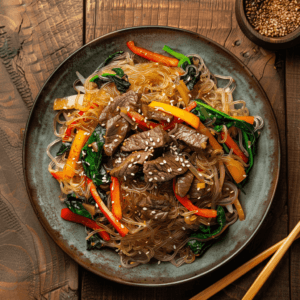
Savory & Slurp-Worthy Japchae: A Taste of Korea in Every Bite
Discover Japchae, Korean glass noodles with vegetables and beef. This easy Japchae recipe brings a delicious and authentic taste of Korea to your kitchen. Learn to make this flavorful and colorful dish at home.
Ingredients
- 1 pound dangmyeon Korean glass noodles
- 1 tbsp sesame oil
- 1 pound beef sirloin thinly sliced
- 1/4 cup soy sauce
- 2 tbsp brown sugar
- 2 tbsp sesame oil
- 2 cloves garlic minced
- 1 small onion thinly sliced
- 2 carrots julienned
- 2 bell peppers various colors, julienned
- 5 ounces fresh spinach washed
- 4 ounces shiitake mushrooms thinly sliced
- Sesame seeds for garnish
Instructions
Soak Noodles:
- Place dangmyeon in a bowl and cover with warm water. Soak for 15-20 minutes until pliable but slightly firm.
Prepare Beef:
- In a bowl, marinate beef with soy sauce, brown sugar, sesame oil, and minced garlic for 10 minutes.
Cook Beef and Vegetables:
- Stir-fry beef until browned. Set aside. Stir-fry onion, carrots, bell peppers, spinach, and mushrooms separately until tender-crisp. Set aside.
Stir-fry Noodles and Combine:
- Drain noodles. Stir-fry noodles in a large pan with sesame oil until softened. Add beef and vegetables back to the pan.
Season and Serve:
- Season with remaining marinade. Toss well. Garnish with sesame seeds. Serve warm or at room temperature.
Notes
- Make it Gluten-Free: Japchae is naturally gluten-free as it uses sweet potato starch noodles. However, always double-check your soy sauce label if you are strictly gluten-free, as some brands may contain wheat. Opt for tamari to ensure it's gluten-free.
- Adjust the Sweetness: Korean cuisine often balances savory and sweet flavors. This recipe leans slightly sweet. If you prefer a less sweet Japchae, reduce the amount of brown sugar. You can also use other sweeteners like honey or agave, but brown sugar provides a richer molasses-like note.
- Vegetable Swaps: Feel free to use vegetables you have on hand or prefer. Consider adding:
- Wood Ear Mushrooms: For a different mushroom texture.
- Zucchini: Adds a mild flavor and soft texture.
- Asian Chives (Buchu): For a subtle onion-garlic flavor.
- Bean Sprouts: For extra crunch. Add these in the last minute of stir-frying to keep them crisp.
- Protein Variations: While beef is classic, you can experiment with other proteins:
- Pork: Thinly sliced pork tenderloin or shoulder works well.
- Chicken: Use boneless, skinless chicken thighs, thinly sliced.
- Tofu: For a vegetarian option, use firm or extra-firm tofu, pressed and cubed. You can pan-fry or bake the tofu before adding it to the Japchae for a firmer texture.
- Seafood: Shrimp or squid, as mentioned in the variations section, are great choices.
- Make Ahead Tips: You can prepare the individual components of Japchae in advance: soak noodles, slice vegetables, and marinate beef. Store them separately in the refrigerator. Stir-fry and assemble just before serving for the best quality. If you need to fully cook it ahead, be aware that the noodles can absorb sauce and become softer over time.
- Reheating: To reheat leftover Japchae, stir-fry it in a pan with a little sesame oil or water to loosen the noodles and prevent drying. Microwaving is also an option, but stir-frying helps retain better texture.
- Serving Suggestions: Japchae is versatile!
- Banchan (Side Dish): Serve it as part of a Korean meal with rice, kimchi, and other side dishes.
- Light Meal: Enjoy a bowl of Japchae on its own as a satisfying and flavorful light lunch or dinner.
- Party Dish: Japchae is excellent for potlucks and parties as it can be served at room temperature and is always a crowd-pleaser.
- Spice Level: For those who enjoy spicy food, add a teaspoon of gochugaru (Korean chili flakes) or gochujang (Korean chili paste) to the marinade and sauce. Adjust to your spice preference.